Folio 4r – Interpretations
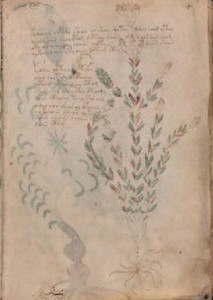 It’s rare for me to look at other researchers’ plant identifications. I’m worried I might be unduly influenced and lose whatever objectivity I may have. The only ones that I’ve perused with any regularity are those by Edith Sherwood, mainly because they pop up frequently on Google when searching for general plant information.
It’s rare for me to look at other researchers’ plant identifications. I’m worried I might be unduly influenced and lose whatever objectivity I may have. The only ones that I’ve perused with any regularity are those by Edith Sherwood, mainly because they pop up frequently on Google when searching for general plant information.
I made an exception for the plant on Folio 4r, however. because my curiosity got the better of me. Was I seeing something different from others? or rehashing old ground?
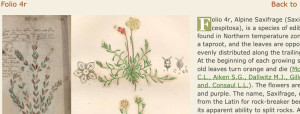 My first search took me, predictably, to Edith Sherwood’s site where Plant 4r is identified as alpine saxifrage (Saxifraga cespitosa). Once again, as I have on the majority of Sherwood’s IDs, I have to disagree—while the leaves and seed capsules may look superficially similar, there are some important differences between S. cespitosa and Plant 4r:
My first search took me, predictably, to Edith Sherwood’s site where Plant 4r is identified as alpine saxifrage (Saxifraga cespitosa). Once again, as I have on the majority of Sherwood’s IDs, I have to disagree—while the leaves and seed capsules may look superficially similar, there are some important differences between S. cespitosa and Plant 4r:
- S. cespitosa does not have the stiff-looking linear leaves of Plant 4r.
- S. cespitosa leaves are palmate and grow mainly around the base, not up along the stem. They also do not form the long branches found in 4r, preferring a more rosette-like habit.
- The seed capsules of S. cespitosa are rounded, but that’s where the similarity ends—there is no little knob at the top, nor are the sepals positioned as they are on 4r.
Given these significant differences, I don’t think it’s likely that Plant 4r is S. cespitosa.
My second search took me to a recent post (July 2013) by Ellie Velinska. where she summarizes some of the IDs already extant on the Web, including one by Steve D. that identifies Plant 4r as Flax (Linum usitatissimum). Steve did a good job of finding a seed capsule with characteristics similar to 4r—it has a rounded center, surrounding sepals, and a central “knob.” Also, the narrow leaves are arranged along the stem rather than forming a basal rosette. I think it’s a more valid proposal than Sherwood’s S. cespitosa but I wasn’t completely convinced the VM illustrator intended L. usitatissimum because flax leaves would not typically be represented with green and red leaves, or with very short, tight leaves. I felt there were plants that might match Plant 4r more closely.
Historic Identifications
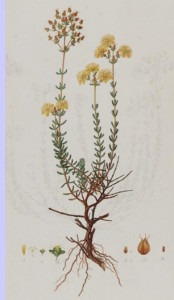 My third search brought me to identifications in the 1940s by Theodore Petersen (no relation), where Centaurium erythraea and Hypericum were suggested. C. erythraea has opposite leaves spaced widely apart, and the seed capsules are long and narrow and not similar to Plant 4r. Hypericum seed capsules are quite variable, from those with two pointed tips to others that resemble a berry, but even those with similar fruits don’t have all the characteristics of 4r and the leaves of Hypericum, while sometimes both green and red, are typically wider and more broadly spaced than Plant 4r.
My third search brought me to identifications in the 1940s by Theodore Petersen (no relation), where Centaurium erythraea and Hypericum were suggested. C. erythraea has opposite leaves spaced widely apart, and the seed capsules are long and narrow and not similar to Plant 4r. Hypericum seed capsules are quite variable, from those with two pointed tips to others that resemble a berry, but even those with similar fruits don’t have all the characteristics of 4r and the leaves of Hypericum, while sometimes both green and red, are typically wider and more broadly spaced than Plant 4r.
Hypericum coris has narrow leaves and reddish stems, but lack the knob on the seed capsules, as do the capsules of H. brachyphyllum and H. fasciculatum. Hypericum repens might be considered except that the leaves are wider and more regularly spaced, rather than clustered, as they are in 4r.
An argument could possibly be made for Hypericum kalmianum, H. linarifolium, or H. cistifolium, as the fruits have both sepals and knob, and the leaves are narrow, but they are more broadly spaced along the stem than 4r and, in the case of H. cistifolium, the leaves are lyrate, a detail the VM illustrator most likely would have noted since lyrate leaves are expressly emphasized on other plants. Also, H. cistifolium has a taproot, rather than the spidery roots of Plant 4r. H. linarifolium and H. lloydii don’t branch in the same way as Plant 4r.
Suggested IDs
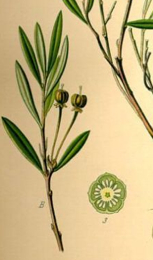 When I first saw 4r, it reminded me of rosemary, especially bog rosemary (Andromeda polifolia), which grows throughout Europe. Bog rosemary has short stiff leaves that alternate up along the stems, rounded seed capsules with surrounding sepals and, at one point (as it ripens, before it turns brown and splits), a little knob on the top. The roots are spindly and they spread in all directions.
When I first saw 4r, it reminded me of rosemary, especially bog rosemary (Andromeda polifolia), which grows throughout Europe. Bog rosemary has short stiff leaves that alternate up along the stems, rounded seed capsules with surrounding sepals and, at one point (as it ripens, before it turns brown and splits), a little knob on the top. The roots are spindly and they spread in all directions.
Dwarf bog rosemary (Andromeda glaucophylla) should also be considered. It has the stiff linear leaves, round, knobbed seed capsules and the upright posture of Plant 4r. The stems are a brownish burnt-orange. It differs mainly in that the leaves are a little longer and less clustered than 4r.
An argument could be made for bog laurel (Kalmia polifolia), especially considering that red and green leaves are often seen together in the fall, but bog laurel has a very long distinct “knob” on the seed capsule, and the leaves are somewhat longer and more broadly spaced than 4r.
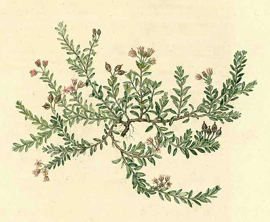 Deserving equal consideration to A. polifolia is Loiseleuria/Azalea procumbens, a low, stiff plant that grows in arctic and alpine environments. The leaves are similar to rosemary, short and narrow, the seed capsules are round, with surrounding sepals and a knob that ranges from short to medium-length. The branching pattern is a reasonably good match for Plant 4r and the leaves are mostly opposite, although some are alternate. Given a choice between the two, it’s difficult to decide which is a closer match, especially considering the limited artistic skills of the VM illustrator. It might be meaningful that L. procumbens is far less common than A. polifolia but I wouldn’t want to assert that one is more likely than the other until more information is available.
Deserving equal consideration to A. polifolia is Loiseleuria/Azalea procumbens, a low, stiff plant that grows in arctic and alpine environments. The leaves are similar to rosemary, short and narrow, the seed capsules are round, with surrounding sepals and a knob that ranges from short to medium-length. The branching pattern is a reasonably good match for Plant 4r and the leaves are mostly opposite, although some are alternate. Given a choice between the two, it’s difficult to decide which is a closer match, especially considering the limited artistic skills of the VM illustrator. It might be meaningful that L. procumbens is far less common than A. polifolia but I wouldn’t want to assert that one is more likely than the other until more information is available.
As for one of the narrow-leaved Hypericum species… it’s possible one of them matches 4r, but the spacing of the leaves is broader than Plant 4r, so it should perhaps only be considered after some of the others.
Postscript: Dec. 2013
Plant Annotations
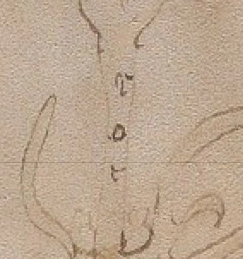 A later search, about half a year after I had written the above, didn’t take me to a plant ID, as I had expected. Instead, I stumbled on the VoynichCrypt and an interpretation of the symbols on the lower part of the plant stem. There is an intriguing and somewhat complex explanation of the page of symbols as the initials T O 2, extrapolated to signify a biblical reference.
A later search, about half a year after I had written the above, didn’t take me to a plant ID, as I had expected. Instead, I stumbled on the VoynichCrypt and an interpretation of the symbols on the lower part of the plant stem. There is an intriguing and somewhat complex explanation of the page of symbols as the initials T O 2, extrapolated to signify a biblical reference.
I think the answer is much simpler. First of all, I don’t think it’s T O 2. If you read this as typical handwritten script of the time, it can be read, from top to bottom as lowercase r o t. Lowercase t in medieval manuscripts is often difficult to distinguish from the letter c except for the slightly straighter top bar. There are German-like words sprinkled throughout the VM, including short annotations on other plant pages, a top margin note, and some of the longer text on the last page. They are not quite German, but close. In German rot means red.
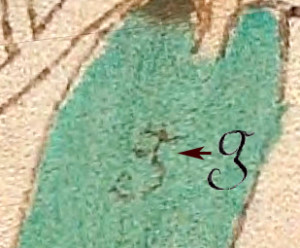 My guess is that the 4r stem annotation describes the color of the stem or (more likely, since the painter’s palette was limited) is an instruction for the color to use for painting the stem, just as the leaf on the plant on Folio 1v has a “g” that may stand for “grün” which is green.
My guess is that the 4r stem annotation describes the color of the stem or (more likely, since the painter’s palette was limited) is an instruction for the color to use for painting the stem, just as the leaf on the plant on Folio 1v has a “g” that may stand for “grün” which is green.
So this link didn’t lead to any further information on the identity of Plant 4r, but it was an interesting side tour into some of the more creative interpretations of the manuscript.
Posted by J.K. Petersen
